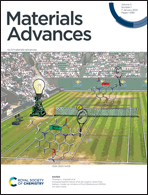Cu-ion-induced n- to p-type switching in organic thermoelectric polyazacycloalkane/carbon nanotubes†
Abstract
The design and scale-up of carbon nanotube (CNT)-based thermoelectric (TE) modules is limited by the low structural similarity between p-type enhancers and n-dopants. This study was aimed at investigating the organic TE properties of polyazacycloalkane/CNT TE films prepared using the drop casting method and the effect of Cu ion doping that can coordinate with its organic ligands. The Seebeck coefficient of cyclen-doped CNTs was −43.3 μV K−1 at 345 K but reduced to 41.6 μV K−1 after adding Cu ions. Cu ion addition switched the charge carrier type of the composite film from electrons to holes owing to cyclen complexation with Cu ions, resulting in a neutral molecular state with suppressed electron donation of the dopant molecules. Notably, conventional approaches cannot maintain sufficient power characteristics owing to the reduced electrical conduction induced by structural defects in the nanotubes. However, herein, an output power exceeding 200 μW m−1 K−2 was obtained, which was 2–5 times higher than that of existing carrier-switchable CNTs. For a typical TE module consisting of five pairs of p-type (Cu(II)-cyclen/CNT)-n-type (cyclen/CNT) junctions, the generated TE voltage and power, depending on the temperature gradient, were similar to the theoretical values. Under optimized conditions, a maximum output power of 1.36 μW was achieved at a temperature difference of 75 K, which is higher than that of previously reported carrier-switchable CNT-based TE modules that used oil-based dopants, whereas we used optimal water-soluble dopants. The proposed approach can help simplify the path from material preparation to module fabrication.



 Please wait while we load your content...
Please wait while we load your content...